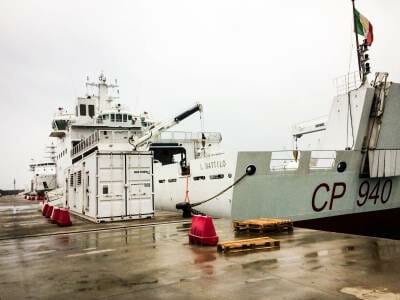Further incidents of self- harm at the Milo CIE. Escape from Vulpitta
Gabriele del Grande, from fortress
europe. Ali slit
his wrists, Ahmed swallowed three bottles of shampoo and Redha put a noose
round his neck. The names have been changed in
order to respect their anonymity. The stories, however, are all too true and
they are not isolated incidents. Standard administrative reports from “the
circles of hell” at the Milo Immigrant Detention Centre (CIE) in Trapani. Where, yesterday
afternoon for the umpteenth time in Section B there were a series of acts of
self-harm and attempted suicides. It was carried out by three Tunsisians, two
of who have been resident in Italy
for many years. Everything kicked off after lunch, when Ali swallowed an iron
screw and a piece of glass and then began to cut his veins. It is as if self-
mutilation is the only means open to him to communicate his despair and his
desire for freedom. A few hours later, in the same section, another Tunisian
ripped up his sheets to hang himself with. Those with him managed to stop him
just in time, before he put his head into the noose and jumped.
They belong to a small group of detainees at
the Milo Centre, there are probably three or four of them altogether. Their period of detention has been extended a further 6 months, under the new law.
The third member of the group having self-harmed was in the hospital wing with
the contents of three bottles of shampoo in his stomach. None of the three
however, has provoked any pity from the staff. And after a short time they are
back in their cells without having been to hospital. It is true that the Milo
CIE only opened last summer, but it seems that those working within the centre
and the security forces are already used to the sight of blood. All of which
says a lot about the frequency of acts of self-harm at the new Trapani maximum security CIE. The management
of which, is the same Insieme
cooperative, part of the Consortium ‘Connecting People’, which operates the
other two Centres in Trapani: the Serraino Vulpitta and Chinisia (which closed
last summer, when Milo opened). Further confirmation of exactly how
unsustainable the situation at Milo has become
comes from another two detainees, who we had the opportunity to talk to. They
told us about the riots in Serraino Vulpitta which led to some detainees
escaping.
The first one we speak to is a young man from Hay Zuhur, an inner-city
area of Tunis,
who ended up in the Rome CIE two and a half months ago, after having served a
two year jail sentence for drug dealing offences. From there, he was
transferred to Milo. He has an 18 month old
son who lives in sheltered accommodation with his mother, who is Italian. He
hasn’t seen her since he was arrested. At the end of his sentence, he couldn’t
wait to hug the mother of his son again, but now he is unable to think about
anything else, other than the further 18 months he must spend behind bars. He
says every day something happens. People who cut themselves or try to hang
themselves; people who protest against the food or the cold. In Trapani, as in other
centres, shoes are taken away from the inmates to reduce the risk of escape and
they are given slippers.
Another
Tunsian, held in a different section of the CIE, not only confirms, but
highlights the fact that those who try to escape or who protest in any way
create more problems for themselves. The police use more violence against them, he tells us asking at the
same time to remain anonymous. He has seen the beatings with his own eyes
carried out on one of his cellmates, an Algerian. He was slapped around the
face in front of the other detainees because he was found with a razor blade on
him during a body search. This happened a couple of weeks ago in Serraino
Vulpitta, the other CIE in Trapani,
after some of the inmates had managed to escape. An incident, which up until
today, we had heard nothing about.
It is known
as the Turin
technique and involves using files to saw away at the bars. The inmates worked
away at them for several days and eventually, according to the stories of those
recently transferred from Vulpitta to Milo,
they managed to escape. Fourteen young Tunisians ran free, while four were
recaptured by security forces. These four were then transferred to Milo along with 16 of the 32 inmates at Vulpitta. These
16 were Tunisians who had recently arrived by boat in Trapani
and others who had been unable to be deported as the Tunisian Consulate in Palermo had not managed
to identify them.
They are all young men
like L, a thirty year old Tunisian who after having lived for 10 years in
Florence has found himself locked up for
the past four months in CIEs. First in Bari and
now in Milo, after the Tunsian Consulate was unable to identify him at Palermo airport. This
means he will not be deported, or rather that he will spend the next 14 months
behind bars before being released. He only hopes to not end up like a fellow
Tunisian at the Milo CIE, who lives under the effects of prescription drugs. He
had been deported, by mistake to Algeria. Algeria
sent him back to Italy
and now it is 9 months that he hasn’t seen a child, a town square or the sea
shore.


